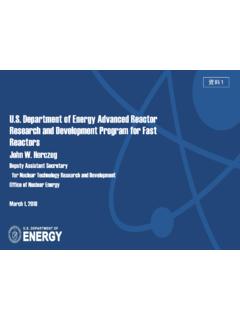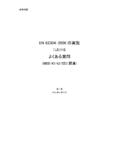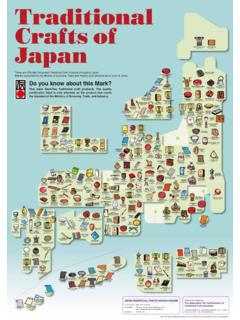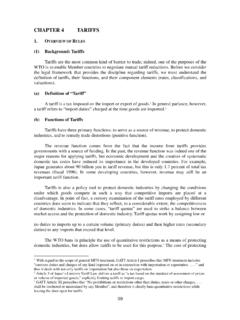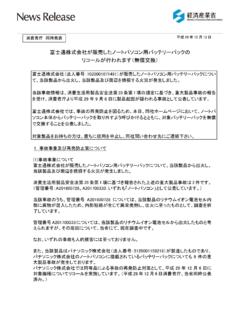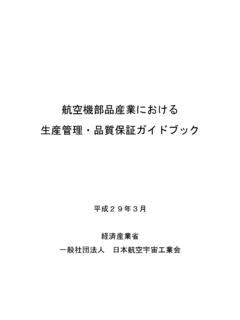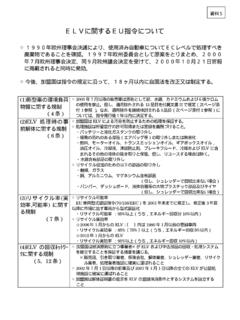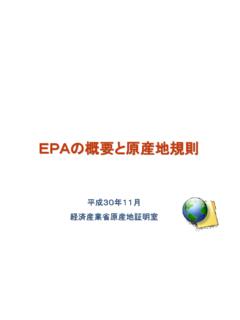Transcription of Part II Overview of the WTO Agreements - 経済産業省 ...
1 Part II Overview of the WTO Agreements 283 Overview OF THE WTO Agreements 1. Basic Objectives of the WTO As stated in the preamble of the agreement Establishing the World Trade Organization, the objectives of the WTO Agreements include raising standards of living, ensuring full employment and a large and steadily growing volume of real income and effective demand, and expanding the production of and trade in goods and services ; in other words, developing the world economy under market-economy principles. In order to contribute to these objectives, the WTO Agreements are established for the purpose of entering into reciprocal and mutually advantageous arrangements designed for the substantial reduction of tariffs and other barriers to trade and to the elimination of discriminatory treatment in international trade relations.
2 This means that the WTO Agreements are structured, for the purpose of introducing market-economy principles into international trade, on the basis of the two ideals: (1) reducing trade barriers, and (2) applying nondiscriminatory rules. Such an approach conforms to the traditional spirit of GATT (The General agreement on Tariffs and Trade), which was carried over from the preamble of the GATT 1947 to the new WTO preamble. In light of the subsequent changes, two objectives were added to the WTO. One is environmental consideration, which entails allowing for the optimal use of the world's resources in accordance with the objective of sustainable development, seeking both to protect and preserve the environment and enhance the means for doing so in a manner consistent with their respective needs and concerns at different levels of economic development.
3 The other is consideration for developing countries, which seeks to recognize that there is need for positive efforts designed to ensure that developing countries, and especially the least developed among them, secure a share in the growth in international trade commensurate with the needs of their economic development. The WTO Agreements also provide more consideration to the interests of developing countries, because the number of its members is by far larger than when GATT was established and single undertaking was a condition of entry. Part II Overview of the WTO Agreements 284 2.
4 Basic Principles of the WTO Agreements (a) Basic Principles of the WTO Agreements As explained above, the WTO agreement is based on the concept of reducing trade barriers and applying nondiscriminatory rules. These ideals are embodied in the following basic principles of the WTO. Principle of MFN (Most-Favored-Nation) Treatment GATT Article I provides that with respect to tariffs, etc. on exports and imports, the most advantageous treatment accorded to the products of any country must be accorded immediately and unconditionally to the like products of all other members (see Chapter 1 Most-Favored-Nation Treatment Principle ).
5 Principle of National Treatment GATT Article III requires that with respect to internal taxes, internal laws, etc. applied to imports, treatment not less favorable than that which is accorded to like domestic products must be accorded to all other Members (see Chapter 2 National Treatment Principle ). Principle of General Prohibition of Quantitative Restrictions GATT Article XI stipulates that No prohibitions or restrictions other than duties, taxes or other charges shall be instituted or maintained by any contracting party and generally prohibits quantitative restrictions.
6 One reason for this prohibition is that quantitative restrictions are considered to have a greater protective effect than tariff measures and are more likely to distort the free flow of trade (see Chapter 3 Quantitative Restrictions ). Principle regarding Tariffs as Legitimate Measures for the Protection of Domestic Industries GATT accepts the imposition of tariffs as the only method of trade control, and attempts to gradually reduce tariff rates for individual items in tariff negotiations. Member countries make concessions ( bind themselves to maximum rates) according to GATT Article XXVIII the imposition of tariffs beyond such maximum rates ( bound rates ) or the unilateral raise in bound rates is banned.
7 In addition, tariff rates are to be reduced in negotiations on a reciprocal and mutually advantageous basis according to GATT Article XXVIII bis (see Chapter 4 Tariffs ). Part II Overview of the WTO Agreements 285 (b) Exceptions to the Basic Principles The WTO Agreements provide important exceptions to the above basic principles. There are two chief reasons for the necessity of these exceptions. The first is that, in order to maintain the multilateral trade system, it is necessary to permit exceptional measures in a controlled manner when specific criteria are met.
8 Thus, the GATT and WTO have provisions that permit exceptions to the basic principles when it is necessary to take measures (so-called trade remedies) to countervail the effects of other countries trade actions (see Chapter 5 Anti-Dumping Measures , Chapter 6 Subsidies and Countervailing Measures and Chapter 7 Safeguards for trade remedies). The second involves a need to consider the ability of a country to implement its obligations based on the degree of its economical development. Thus, the WTO Agreements permit the protection of domestic industries via tariffs and contain various exception provisions to its principles for developing countries.
9 The exceptions are established because of the difficulty involved in applying the principles of the multilateral system to the real international economy. The WTO Agreements try to harmonize reality and principles by specifying the requirements for allowing exceptions in certain cases. While the WTO s attitude can be highly praised for its forward-looking realism, there exist abuses of the exception provisions because of ambiguities among the requirements. The WTO Agreements improved some provisions of GATT that were hotbeds of abuse by clarifying their requirements.
10 However, there still remain some unsatisfactory provisions. Further clarification is one of the challenges facing the WTO. 3. Overview of the WTO Agreements Figure II-1 provides an Overview of the WTO Agreements . The WTO Agreements comprise the agreement Establishing the World Trade Organization and its Annexes. Annexes 1A to 3 are integral parts of the agreement and are binding on all members of the WTO ( single undertaking mentioned earlier). As shown in Figure II- 2, the members are 153 economies as of February 2010. In contrast, the Agreements included in Annex 4 are independent Agreements and, therefore, binding only on the members that have accepted them.
